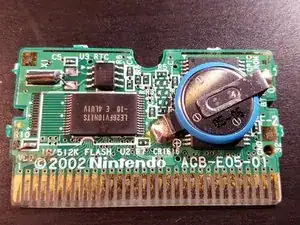
Battery
Es werden einige allgemeine Werkzeuge verwendet, um an diesem Gerät zu arbeiten. Du wirst nicht jedes Werkzeug für jeden Vorgang benötigen.
The GameBoy Advance cartridge is a plastic case containing a circuit board, a ROM chip, and a connector that allows it to interact with the GameBoy Advance console itself. The ROM (Read-Only Memory) chip stores the information needed to run the specific game the cartridge is dedicated to. ROM cartridges were helpful because they allowed the user to quickly load programs without an expensive floppy drive, or the more unreliable Compact Cassette tape.
The phenomenon of taking a cartridge or other component out of the main device and blowing on it to fix it actually originated with Nintendo cartridges! Whenever a game refused to load, the secret solution (much like ‘turn it off and then on again’) was to remove the cartridge, blow on the contact points, and replace it. Although this runs the risk of rusting the contact points, and an informal study has stated that it probably didn’t help, the practice was widespread across cartridge-based consoles like the GameBoy Advance owners.
About 1,501 games were released for the GameBoy Advance using cartridges during its lifetime. You can access a list of them here. Some GameBoy Advance titles, such as the Pokemon games, had issues with the internal battery of the game cartridge and were usually met with the following message when opening the game: “The internal battery has run dry. The game can be played.” Many users faced this problem, and there is a forum here that describes the problem in more detail and offers solutions.
Information on the GameBoy Advance, a 2001 Nintendo console, can be found here. Nintendo has released several consoles that use cartridges, including the original NES (Nintendo Entertainment System), the Game Boy and its variations, and the DS series.